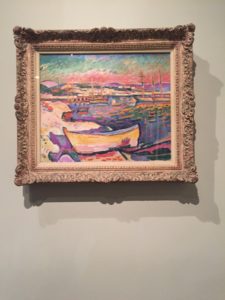LACMA
I loved going to LACMA. It was a great opportunity to finally see some of the art or art similar to what we have talked about and viewed in the classroom. The first impression after viewing the art in  person is that the artists we have talked about in class are even more impressive than I initially thought. My favorite area was the new artist gift section. I really enjoyed seeing George Braque’s painting first hand. I was enamored by “Boats on the Beach.” This painting is definitely more on the surrealist end of Braque and displays more colors than most of his paintings. I expected the colors on a lot of the paintings to be more washed out than they are on the computer, because photoshop allows for color enhancement, but I was proven wrong. If anything the colors are more vibrant! Additionally being able to see each individual brush strokes adds depth and intrigue to this painting. The painting is also quite large and it was framed in a beautifully white wood carved frame. I think going to LACMA made the whole class a lot more purposeful, because I got to apply the knowledge gained from the course to the paintings I looked at. I think I will go back to LACMA because I only got to go through one building really thoroughly. Great Experience!
person is that the artists we have talked about in class are even more impressive than I initially thought. My favorite area was the new artist gift section. I really enjoyed seeing George Braque’s painting first hand. I was enamored by “Boats on the Beach.” This painting is definitely more on the surrealist end of Braque and displays more colors than most of his paintings. I expected the colors on a lot of the paintings to be more washed out than they are on the computer, because photoshop allows for color enhancement, but I was proven wrong. If anything the colors are more vibrant! Additionally being able to see each individual brush strokes adds depth and intrigue to this painting. The painting is also quite large and it was framed in a beautifully white wood carved frame. I think going to LACMA made the whole class a lot more purposeful, because I got to apply the knowledge gained from the course to the paintings I looked at. I think I will go back to LACMA because I only got to go through one building really thoroughly. Great Experience!





 detail becomes more vague and abstract. Another
detail becomes more vague and abstract. Another snow. This contrasts the man-made aspects of the painting (the buildings) and the natural aspects (mountains and snow). Another contrasting part of this painting, is the transition from warm colors on the left side of the canvas, to neutral colors in the middle (the lake), to colder colors on the opposing side. Composition wise, there is no specific object that Monet focuses on, each part of the canvas is essential to the overall effect. The transition of color from one side of the illustration to the other side of the illustration in conjunction with the short brushstrokes conveys the illusion that the sun has set, and the remnants of light are hitting the mountains. The warmth of the sunset brings a new sense of beauty to otherwise dull winter scene . The light projected by the sunset makes the audience feel like there is hope and happiness in winter, a seemingly cold lonely season.
snow. This contrasts the man-made aspects of the painting (the buildings) and the natural aspects (mountains and snow). Another contrasting part of this painting, is the transition from warm colors on the left side of the canvas, to neutral colors in the middle (the lake), to colder colors on the opposing side. Composition wise, there is no specific object that Monet focuses on, each part of the canvas is essential to the overall effect. The transition of color from one side of the illustration to the other side of the illustration in conjunction with the short brushstrokes conveys the illusion that the sun has set, and the remnants of light are hitting the mountains. The warmth of the sunset brings a new sense of beauty to otherwise dull winter scene . The light projected by the sunset makes the audience feel like there is hope and happiness in winter, a seemingly cold lonely season.